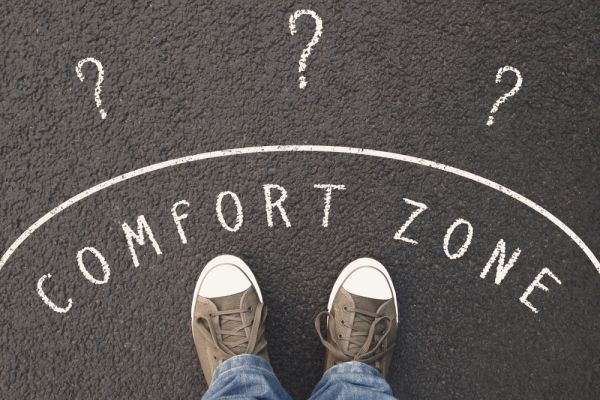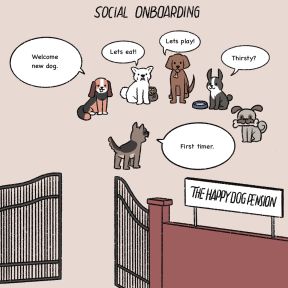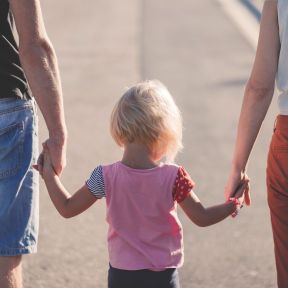Children and Anxiety
Anxiety is on the rise among children and adolescents. Studies show that as many as one in eight children may experience significant anxiety. Knowledgeable observers offer a number of reasons. Perhaps most important, children’s lives have changed so that there is almost nonstop sedentary screen time at the expense of play and physical activity, experiences through which children traditionally decompress, work out their concerns, and form supportive relationships. And what’s on those screens are, often enough, new opportunities for young people’s worry.
In addition, in almost every domain of life, there is far more uncertainty, and uncertainty breeds anxiety. In response to an array of economic and cultural shifts, parents today commonly put significantly more pressure on their children to achieve than did parents of a generation or two ago, and many children, carrying the burden of outsize expectations, worry about meeting them. Further, overprotected more than previous generations, children grow up not merely without opportunities to develop problem-solving skills but without the belief that they can adequately cope with the threats life throws their way. Helicopter parenting fosters the development of anxiety in children.
On This Page
- When do children develop the capacity to worry?
- What do children worry about?
- What does anxiety look like in a child?
- What types of anxiety are common in children?
- What makes children vulnerable to anxiety?
- Do children get anxious if a parent is anxious?
- Are there some parenting practices that make children vulnerable to anxiety?
- How can I know if my child is anxious in school?
- Do children ever outgrow anxiety?
- What are the best treatments for a child with anxiety?
- How does anxiety affect child development?
- Are there some things to say or not to say to an anxious child?
- What is the best way to help a child manage anxiety?
Anxiety requires a certain amount of cognitive development. Newborn infants have some built-in fears, but it takes a while for the capacity for anxiety—worrying about the possibility of a future bad outcome—to come online. Imagination is required, and that capacity is expressed most clearly in the development of pretend play, emerging around age 2.
Much everyday observation and many studies show that at approximately 8 months of age, infants develop a fear of being separated from their mother or other caregiver and become clingy. In fact, the reaction of toddlers to brief separations from parent or caregiver is commonly used as a test of the strength of attachment. Separation anxiety between ages 18 months and 3 years is a normal developmental stage. Separation anxiety becomes problematic if it persists into the school years and causes children to fear leaving home or getting lost.
Children worry, and they feel alone with their worries. Early on, they worry about shadows, ghosts, and monsters or imaginary creatures under the bed or in the closet. They worry about fires and disasters and other events they can’t control. As they move into the larger world in childhood, they worry about their family, especially their parents. They worry that arguments between their parents might mean divorce and the end of their family. They worry about a parent dying or leaving, about having to choose between parents, and about where they will have to live. Children may overhear parts of conversations between parents or others, draw unwarranted but troubling conclusions, and spend a great deal of time silently ruminating about events they lack full comprehension of.
Children worry about school, about getting called on in class, getting bad grades, and getting bad teachers. They worry about being late. They worry about school shooters, and their worry is often reinforced by the frequent “shooter drills” that schools are required to have. Children worry about being accepted and liked by their peers, being bullied or humiliated, being excluded from online conversations and real-life parties, and losing friends. They also worry about making mistakes and not pleasing their parents or not meeting their parents’ expectations for them.
Studies show that, even among adolescents, exposure to negative conflict between parents creates anxiety in children by threatening children’s sense of security. The anxiety creates hypervigilance, and as a result of exposure to conflict, their attention is biased toward disproportionately noticing negative conflict, reinforcing their cause for worry. And, yes, children of all ages are immersed in the world around them and worry about the larger world, too. They may worry about their family’s financial woes—or their own prospects for getting a job. They worry about terrorists and the effects of climate change. Normal worries become problematic when they interfere with sleep, going to school or paying attention in school, or engaging in activities with others.
Anxiety is an increasingly common problem among children today. The Centers for Disease Control and Prevention reports that 7 percent of children age 3 to 17 have a diagnosed anxiety disorder; the average age of onset is 11 years. Yet many believe that anxiety is vastly underdiagnosed and underrecognized in children. Children often display anxiety by asking repetitive “what if” questions—“What if there’s a fire?” ’What if you get sick?” Logical explanations and attempts at reassurance don’t suffice. Children may reveal anxiety in expressing concern about an event very far off in the future. They may be overly or unnecessarily apologetic, suggesting worry whether others have reason to be upset with them.
And then there are all the physical manifestations of anxiety—general jitteriness, palpitations, headaches, stomachaches, and not feeling well enough to go to school. Anxiety can create problems falling asleep or staying asleep, or it can disrupt sleep with nightmares. It can also show up as problems remembering things or concentrating on things. School refusal is a common problem among children with anxiety. It may take the form of not wanting to get out of bed on school mornings. Poor school performance can be a sign a child is preoccupied with worry. Because avoidance is a common, if maladaptive, approach to anxiety-provoking situations, anxious children may be unwilling to participate in experiences others eagerly embrace—going to friends’ houses, or family outings or vacations. Refusing to be separated from parents is a common sign of anxiety in children.
Children can develop specific phobias or they can develop more broad-based anxiety disorders. More rarely, they can manifest obsessive-compulsive disorder. In extreme cases, they may develop selective mutism. Most common, however, are separation anxiety, social anxiety, and generalized anxiety disorder. Separation anxiety is normal—in toddlers. They experience anxiety when a parent leaves the room or drops them off at daycare. But they can be distracted and the distress they manifest subsides. Separation anxiety is a disorder in school-age children who can’ bear to be separated from a parent or refuse to leave home to go to school. It is most common among children 7 to 9 years old.
Social anxiety disorder sometimes called social phobia, is more common among older children; they display anxiety and excessive self-consciousness in routine social situations. They have a fear of being observed—and judged. It can keep children from wanting to go to school or engaging in any activity that puts them in the spotlight, such as speaking up in class or even reading a passage if called on to do so. Social anxiety disorder reflects a specific worry—negative judgment by others—and it is manifest only in social settings.
In contrast to social anxiety disorder, which reflects a specific worry—negative judgment by others—and occurs only in social settings, generalized anxiety disorder can encompass any extended periods of worry in any of the major domains of life—health, family, home, school friendships, natural disasters, the environment. It is accompanied by physical symptoms such as jitteriness and difficultly sleeping as well as difficulty concentrating. Both types of anxiety are amenable to treatment with psychotherapy.
Children can be vulnerable to anxiety if they are born with the touchy temperament of behavioral inhibition; they do not willingly explore their environment and may find new experiences threatening because the amygdala is highly reactive or circuitry connecting the amygdala, hippocampus and prefrontal cortex fails to recognize repeated stimuli. Studies show that approximately 20 percent of Caucasian children are born with such a reactive temperament, inclining them to shyness, timidity, and anxiety. Yet, despite such a temperamental tilt toward anxiety, it’s how parents react to their children’s temperament that influences whether anxiety develops; their actions can prevent anxiety or allow it to persist. In classic long-term studies of such children, psychologist Jerome Kagan found that if they are allowed to find their own adaptive niche, they grow up to function well.
Children can acquire anxiety through early traumatic experiences. Or they may be consistently exposed to childrearing practices that transmit parental worries, that limit the acquisition of problem-solving skills, or that generate self-doubt. Failing to equip children to enter adulthood is a special problem among Millennials and Gen-Zers.
Too, children may become anxious through overexposure to information about worrisome things—economic crises, global warming, political upheaval. Further, while some degree of anxiety is normal, and children may need help learning to put anxiety in its place, they naturally differ in the degree to which they are aware of and sensitive to the physical components of anxiety. Some children may just feel anxiety more.
There is also widespread consensus that the emergence of social media is linked to high levels of anxiety in young people, particularly in adolescence. Despite enabling connectedness, the technology breeds social anxiety by providing new means of social quantification, nonstop opportunities for social comparison, and new pathways for social exclusion and bullying. And because social media never stops, it can generate a fear of missing out and doubts about self-adequacy that manifest in anxiety. Here’s an important irony to consider about social media: Many studies show it actually increases children’s sense of isolation. Isolation, in turn, magnifies the perception of threat, which is where anxiety starts.
Children can get anxious if a parent is anxious, but that doesn’t in any way indicate how the anxiety is transmitted. Often, anxiety is transmitted to children unwittingly through an array of parental practices—talking to children about adult concerns, depriving children of opportunities to learn coping skills, and through accommodating children’s anxiety. Anxiety, with its payload of physical and cognitive distress, is a natural mental state, and, as with all emotional experiences, children benefit from learning constructive ways of handling the distress.
Too often, however, contemporary parents protect their children from the distress of anxiety and accommodate the children in avoiding anxiety-provoking conditions. The upshot, studies show, is that children become more anxious and intolerant of uncertainty, never learning how to become comfortable with the discomfort, how to persist in spite of it, or how to tackle the problem that is the source of the anxiety.
In general, parents who have trouble with the law, consistent problems in relationships, or recurring difficulty managing their own life, or any of the demands of adulthood, are apt to generate anxiety in their children. Similarly, parents who fail to keep their promises to their kids or whose behavior toward them is erratic and unpredictable are signaling stronger than words can express that they are unreliable as guardians. Anxiety is a whole-body response to threat; it dissipates only when people feel safe—when children apprehend that the adults are capable of taking care of the children and can handle life’s challenges through their own resources.
More specifically, parents who do not give their children permission to experiment and fail, or who take over difficult task from them, rather than provide coaching and encouragement from the sidelines, are setting kids up for anxiety. So too are parents who do not let their children get comfortable with some degree of distress. Only by learning that distress is tolerable (to say nothing of expectable) can children find their own way through it and come out with the confidence that they can keep themselves safe in many circumstances.
School performance is often a good barometer of children’s mental health. Anxiety can rob children of the ability to pay attention in school, and class engagement and participation may suffer as well as grades. So may the power to concentrate on homework or other tasks, or even to remember to do them. Teachers are usually good observers of children’s patterns and are quick to spot changes in concentration, participation, and performance.
Periodic conversations with teachers can elicit revealing information about children’s behavior that may otherwise be invisible to parents. In addition, parents who put everything else aside for a few minutes every day to have regular conversations with their children about whatever is on their mind and going on in their life are in a privileged position to hear directly when concerns arise. That might be the only way they learn about such experiences as bullying, which often escape notice by teachers and administrators but are a strong disincentive for going to school.
Unfortunately, children are far more likely to grow into their fears than out of them if anxiety is not addressed. Anxiety is considered a marker—a gateway to other mental health problems. The sooner it is addressed, the less likely it is to lead to serious mental health conditions. Without treatment anxiety is apt to persist, interfere with children’s social function and development, and wreak havoc on family life. It leads not just to future anxiety but to depression, substance use, and risk for suicide. As for treatment, it’s most helpful if children learn the cognitive skills to challenge worry and to tame their own fearful imagination.
The data are clear: Many studies show that the best way to treat the growing problem of childhood anxiety —better than a placebo, better than pharmaceutical approaches—is with cognitive behavioral therapy (CBT). It gives children the tools to disarm anxiety for a lifetime. Working with a therapist, usually in a course of 12 sessions, children acquire the ability to face their worries. They learn what triggers their anxieties and they learn that the perceptions of threat that send distress signals throughout their body are nevertheless false.
They learn how to rationally challenge those perceptions, and to substitute negative thinking patterns with positive ones. CBT teaches the anxious to question their beliefs and learn that feared situations are safe. Another widely validated treatment is exposure therapy, particularly for phobias and social anxiety. In a safe setting children are gradually introduced to the element that triggers their fears, until they are no long reactive to it. It is highly affective.
Attention bias modification therapy (ABMT) is an emerging treatment. It is based on research showing that both children and adults with anxiety are overly attuned to negative events in their environment, such as upset or angry faces. They preferentially notice and give weight to them, ignoring neutral or even positive stimuli. Such a cognitive bias toward threat ushers in pathological anxiety. In brief, screen-based sessions, children are shown a series of photographs of actors making specific facial expressions. ABMT retrains attention away from threat, averting the hyperstimulation of the amygdala that sets off neural alarms.
Anxiety adds a stress on development at a time when children and families are experiencing many stresses—and children have fewer outlet for play and other activities that relieve pressure. If parents or others accommodate children’s worries and allow young people to avoid those situations that give rise to worry, children miss out on experiences are essential for full development socially and emotionally. In addition, the children have no way to discover how to disarm their concerns, and they do not learn how to live with uncertainty. Giving in to fear doesn’t help a child learn to solve the problem that gives rise to anxiety.
Mental health problems are isolating, and children benefit by knowing that they are not alone in their experience of worry and that every single person on earth experiences anxiety at some time. Children find courage in hearing stories from admired adults who have faced worries similar to theirs and found ways to cope with such worries.
Experts encourage parents to help children face their worries, rather than accommodate them—to not alleviate a child’s anxiety by yielding to the distress. Allowing children to withdraw from activities that generate the discomfort of anxiety reinforces the sense of threat, deprives children of experiences that are important for development, and keeps children from developing the sense of self-efficacy that comes from mastering life’s little and big challenges. Giving in to the fear doesn’t work. Studies show that it is counterproductive—it increases children’s anxiety. Children do best when they are shown how to disarm their own worries or encouraged to discover their own ways to do so.
Don’t dismiss or belittle children’s concerns. If they’re worrying about something, it is something to worry about. Don’t try to talk children out of their concerns—without showing them how to do it. Similarly, don’t tell them to calm down; show them how (learning to deep-breathe is one of the most effective tools imaginable; it directly stimulates the parasympathetic nerve to quiet the physical symptoms oof anxiety. Have children blow bubbles or blow out the “candles” of your fingertips.
According to surveys by the American Psychological Association, parents are alarmingly unaware of children’s anxiety. Children may feel ashamed about their distress; it’s not something to announce over the dinner table. Or parents are too busy to give full attention to those moments when their children might be looking for a way to confide; it’s hard to feel heard when the other person is holding a cell phone. Sometimes parents are dismissive of children’s feelings, and assuring a worrying child “there’s nothing to worry about” is dismissive, not reassuring or helpful. But there are things a parent can do to manage a child’s anxiety:
• Listen to concerns; don’t dismiss children’s feelings. Just feeling heard is comforting.
• Encourage emotional literacy. Teach children about anxiety in an age-appropriate way. Teach them that it shows up in physical signs—arousal and jitteriness—and a mental track of worry Let them know its normal but sometimes gets the upper hand. Many find that the concept of false alarms is a helpful one.
• Limit children’s exposure to news of disasters and catastrophic events. Eventually children will develop the cognitive capacity to handle such information, but constant replay magnifies the sense of threat.
• Allow time for relationships. Anxiety results when children do not feel safe. Relationships of all kinds—with parents, with other family members, with peers, with teachers—are natural antidotes to anxiety.
• Encourage play and physical activity. The physical tension that anxiety creates can often be dissipated by play and exercise. Making sure that children have regular opportunities for such activities gives them important tools for regulating their own emotions and managing their own mental health.
• Offer specific skills for dissipating the discomfort anxiety creates. Teach kids deep breathing, which subdues the nerves of alarm.
• Keep your own anxieties to yourself. Do not share them with your children.














